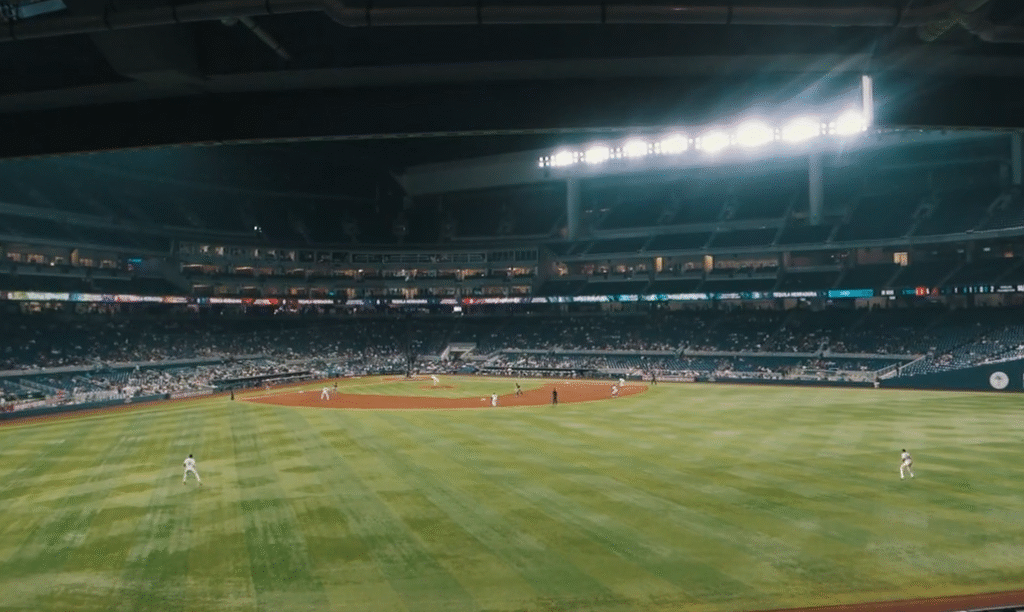Few Major League Baseball stadiums have seen such a significant change in public opinion as Loandepot Park. Due to poor attendance and low crowd energy, the venue received a lukewarm reception only a few seasons ago. But recently, it has drawn national attention—not just because of the Miami Marlins’ exciting games, but also because of its lively atmosphere, cutting-edge architecture, and remarkably distinct identity as a center of culture.
An all-time franchise high of 101,545 fans attended three games in a recent series against the New York Yankees at Loandepot Park. For background, outside of Opening Day, the same stadium had previously had trouble reaching the 20,000 mark. Clayton McCullough, the manager of the Marlins, said the change has been “extremely encouraging” for team morale. He underlined how the recent enthusiasm from the fans gave a noticeable boost, especially when things got tight on the field.
The park’s architectural design is not only remarkably contemporary, but it also operates with great efficiency. Despite Miami’s infamously humid weather, fans can enjoy games in comfort thanks to the retractable roof and air conditioning. For families, tourists, and senior citizens who might otherwise avoid midday games, this has made it especially advantageous. Loandepot Park provides a distinctively climate-controlled experience without compromising the thrill of live sports, in contrast to outdoor stadiums in locations like Texas or Arizona.
Loandepot Park – Fast Facts
| Attribute | Detail |
|---|---|
| Name | LoanDepot Park |
| Location | 501 Marlins Way, Miami, Florida 33125 |
| Team | Miami Marlins (MLB) |
| Capacity | 37,000 |
| Opened | March 5, 2012 |
| Owner | Miami-Dade County |
| Surface | Shaw Sports B1K synthetic turf (since 2020) |
| Architecture Firm | Populous |
| Construction Cost | $634 million (approx. $868 million in 2024 dollars) |
| Features | Retractable roof, climate-controlled interior, modern digital screens |
| Nearby Landmark | Built on the former site of Miami Orange Bowl in Little Havana |
| Official Source | MLB – LoanDepot Park |

The stadium provides a very diverse entertainment environment for supporters who are interested in more than just what is happening on the field. Loandepot Park hosts cultural festivals, civic gatherings, and concerts in addition to its Major League Baseball games. For example, during Flanis Fest, dancers performed close to the outfield concourse while local food vendors served traditional Cuban fare. The venue’s emotional resonance with nearby communities has greatly increased as a result of these cultural integrations. The stadium has transformed into a joyous landmark for Little Havana and greater Miami rather than serving as a sterile sports venue.
The Marlins have improved ties with the local communities by implementing clever marketing strategies like Boca Raton Day, which gives locals discounted tickets and reserved seating. It was more than just a publicity stunt when Mayor Scott Singer threw out the ceremonial first pitch; it was a symbolic link between the team and the city. The team’s local fan base has grown significantly as a result of this approach to fan engagement, which blends accessibility and civic pride.
The visitor experience has also been significantly enhanced by the stadium’s technological upgrades. Operations are now very efficient, from digital food ordering to responsive customer service and mobile ticketing. The stadium has continuously received praise from visitors for being aesthetically pleasing, well-maintained, and easy to navigate. The careful planning and excellent functionality of Loandepot Park’s design have been recognized even by frequent critics of more recent ballparks.
Though there have been sporadic grievances—like a lack of gluten-free food options or expensive concessions—the overwhelmingly positive reviews from visitors have greatly outweighed these criticisms. Numerous internet reviews emphasize the friendly staff, breathtaking views of Miami’s downtown, and the improved seating areas, especially in the PNC Club and other premium areas. Even supporters of the opposing team have recently expressed their admiration for the improved game-day experience on social media, describing it as “surprisingly affordable” in comparison to venues in New York or Los Angeles.
The recovery of Loandepot Park fits into a larger trend in sports entertainment where spectator satisfaction is just as crucial as on-field success. MLB venues are now evaluated on how interesting, approachable, and pleasurable they are from start to finish, much like streaming services compete not only on content but also on usability. The Marlins have obviously taken notice, making significant investments in social activations and event programming that appeal to younger audiences.
The Marlins are creating a model that other teams might soon follow by converting Loandepot Park into a cross between a sports arena and a cultural plaza. Teams like the Athletics and Diamondbacks are reportedly consulting with designers involved in the Miami build, indicating that even architectural firms are interested. It is a stadium that serves as an example of how, in a matter of seasons, embracing local culture, smart technology, and immersive fan experiences can change public perception.
The stadium represents Miami’s dedication to fusing innovation and tradition within the framework of the city’s larger revitalization. The building reimagines history rather than erasing it, even though it stands tall on the ashes of the storied Orange Bowl. Loandepot Park has gone from being a lackluster event to one that will be remembered thanks to rising celebrity attendance, community involvement, and record-breaking fan numbers.

